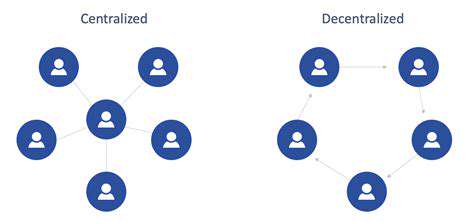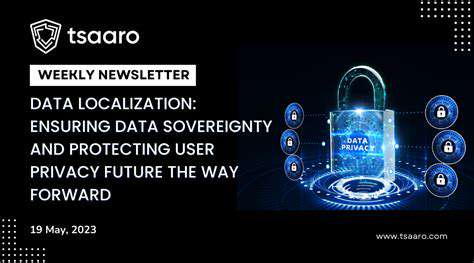Edge Computing for Smart Homes: Localized Control and Privacy
Real-World Applications of Edge Computing
Industrial automation provides compelling examples of edge computing's value. Manufacturing plants now deploy edge systems that detect equipment anomalies in real-time, preventing costly production halts. These systems analyze vibration patterns, thermal signatures, and power consumption locally, triggering maintenance alerts before humans notice any issues.
The automotive sector demonstrates edge computing's life-saving potential. Self-driving cars process terabytes of sensor data per hour - an impossible load for cloud-only architectures. Onboard edge systems make instantaneous navigation decisions while filtering what gets sent to central servers. This hybrid approach balances real-time responsiveness with long-term data analysis needs.
The Impact on Data Security and Privacy
Edge computing reshapes security paradigms by limiting data exposure. Traditional cloud models create honeypots of sensitive information, while edge architectures distribute risk. Properly configured edge nodes implement military-grade encryption where data originates, creating multiple defensive layers instead of a single vulnerable perimeter. This granular security approach aligns well with modern privacy regulations.
Privacy-conscious homeowners particularly benefit from edge computing's data minimization. Video doorbells with edge processing can detect package deliveries without uploading footage to the cloud. Voice assistants can respond to basic commands locally, only reaching out to servers for complex queries. These implementations give users tangible control over their digital footprints.
Challenges and Future Trends in Edge Computing
The edge computing landscape faces growing pains. Manufacturers currently grapple with a bewildering array of hardware standards, forcing custom integrations for each deployment. The industry desperately needs unified protocols to simplify edge system development and maintenance. Until then, implementation costs remain prohibitively high for some applications.
Emerging trends point toward increasingly intelligent edge devices. The next generation will embed specialized AI chips capable of running sophisticated machine learning models locally. 5G networks will augment these capabilities with ultra-low latency connectivity, enabling new use cases like remote surgery and augmented reality maintenance. The edge-cloud continuum will become increasingly seamless, with workloads dynamically shifting based on real-time needs.
Decentralized Data Processing for Enhanced Speed and Responsiveness

Decentralized Data Storage
Modern data ecosystems increasingly adopt decentralized storage models that fundamentally differ from traditional server farms. These distributed networks replicate information across numerous nodes, creating inherent redundancy that protects against outages and censorship. This architecture provides unparalleled resilience - where centralized systems represent single points of failure, decentralized networks automatically reroute around problems. The approach particularly benefits applications requiring guaranteed uptime.
Content delivery networks pioneered early decentralized concepts, but blockchain technologies perfected the model. Today's implementations use sophisticated algorithms to distribute encrypted data shards across participating nodes. Even if multiple nodes disappear, the system automatically reconstructs complete datasets from remaining fragments. This self-healing capability makes decentralized storage ideal for mission-critical applications.
Data Integrity and Security
Decentralized systems employ cryptographic proofs to maintain data authenticity. Each transaction receives a unique digital fingerprint that subsequent operations must reference, creating an unbreakable chain of custody. These mathematical safeguards make decentralized systems virtually tamper-proof - altering any record would require simultaneously changing every subsequent record across the entire network. The computational impracticality of such attacks provides security assurances that centralized systems struggle to match.
Permissioned blockchain variants add another security layer through granular access controls. Enterprises can implement decentralized architectures while restricting participation to vetted nodes. This hybrid approach combines decentralization's resilience with corporate security policies, making the technology palatable for regulated industries like healthcare and finance.
Scalability and Performance
Traditional databases hit performance walls as datasets grow, but decentralized systems scale differently. The addition of each new node actually increases the network's aggregate processing power and storage capacity. This inverse scalability curve enables decentralized networks to handle workloads that would cripple centralized alternatives. The approach particularly shines for global applications needing low-latency access across continents.
Innovative sharding techniques further enhance performance. Rather than requiring every node to process every transaction, modern decentralized systems partition workloads intelligently. This parallel processing capability enables throughput that rivals traditional databases while maintaining decentralization's core benefits. The technology continues evolving to support increasingly demanding applications.
Transparency and Auditability
Decentralized ledgers provide unprecedented transaction visibility while preserving privacy through cryptographic techniques. Every network participant can verify the system's state without seeing sensitive details. This balanced transparency builds trust in scenarios requiring accountability, from supply chain tracking to financial settlements. The immutable audit trail also simplifies regulatory compliance across jurisdictions.
Cost-Effectiveness
Decentralized models disrupt traditional infrastructure economics by harnessing underutilized resources. The approach turns cost centers into revenue opportunities - participants can monetize spare storage and compute capacity while contributing to the network. This shared economy model drives down costs compared to maintaining private infrastructure. The savings become particularly significant for data-heavy operations like video streaming or scientific computing.
Eliminating intermediary fees creates additional savings. Traditional payment processors, cloud providers, and other middlemen take substantial cuts from transactions. Decentralized alternatives facilitate direct peer-to-peer interactions, passing the savings to end users. These economic advantages accelerate adoption across industries.
Future Applications
Healthcare stands poised for decentralized transformation. Patient records could reside on secure networks where providers access needed information without centralized repositories. Clinical trial data could maintain perfect integrity across research institutions. These applications demonstrate decentralized technology's potential to solve longstanding industry challenges while improving outcomes.
The energy sector presents another promising frontier. Decentralized systems enable peer-to-peer energy trading between solar panel owners and neighbors. Microgrids could autonomously balance supply and demand using smart contracts. These innovations point toward a more resilient and sustainable energy future powered by decentralized principles.

Future Applications and the Potential of AI Integration
Enhanced Real-time Decision Making
The fusion of AI and edge computing creates responsive smart homes that anticipate needs. Local AI processors analyze usage patterns to predict actions before they're needed - preheating ovens when dinner prep typically starts or adjusting lighting based on sunset times and observed preferences. This proactive approach transforms homes from reactive appliances to intelligent partners.
Personalized User Experiences
Edge-based AI enables nuanced personalization impossible with cloud-only approaches. Systems learn individual family members' preferences down to granular details - how firm to make the mattress for each sleeper, which news topics to highlight with morning briefings, or optimal shower temperatures for different times of day. These tailored experiences feel increasingly intuitive as the systems continuously refine their models.
Improved Security and Privacy
AI-enhanced edge devices implement sophisticated security locally. Cameras distinguish between family members, pets, and strangers without uploading footage. Voice assistants process sensitive requests on-device. This localized intelligence creates security buffers - even if cloud connections are compromised, the most sensitive processing remains protected within the home's physical boundaries.
Automation and Efficiency Gains
Intelligent edge systems optimize home operations holistically. They coordinate appliances to minimize energy costs based on real-time pricing and usage patterns. AI manages complex tradeoffs - delaying the dishwasher during peak rates but ensuring completion before morning, or precooling the house before expected heatwaves. These optimizations compound into significant savings while maintaining comfort.
Predictive Maintenance and Proactive Actions
Edge AI transforms home maintenance from reactive to predictive. Water sensors don't just detect leaks - they analyze flow patterns to predict pipe failures before they occur. HVAC systems monitor performance degradation to schedule tune-ups during optimal times. These capabilities prevent costly emergencies while extending equipment lifespans through timely interventions.
Scalability and Flexibility in Smart Home Design
The edge-AI combination future-proofs smart homes. New devices integrate seamlessly through standardized local APIs rather than requiring cloud dependencies. Homeowners can start with basic automation and add sophisticated features over time. This modular approach makes advanced home intelligence accessible across budget levels while ensuring systems remain upgradable as technologies evolve.